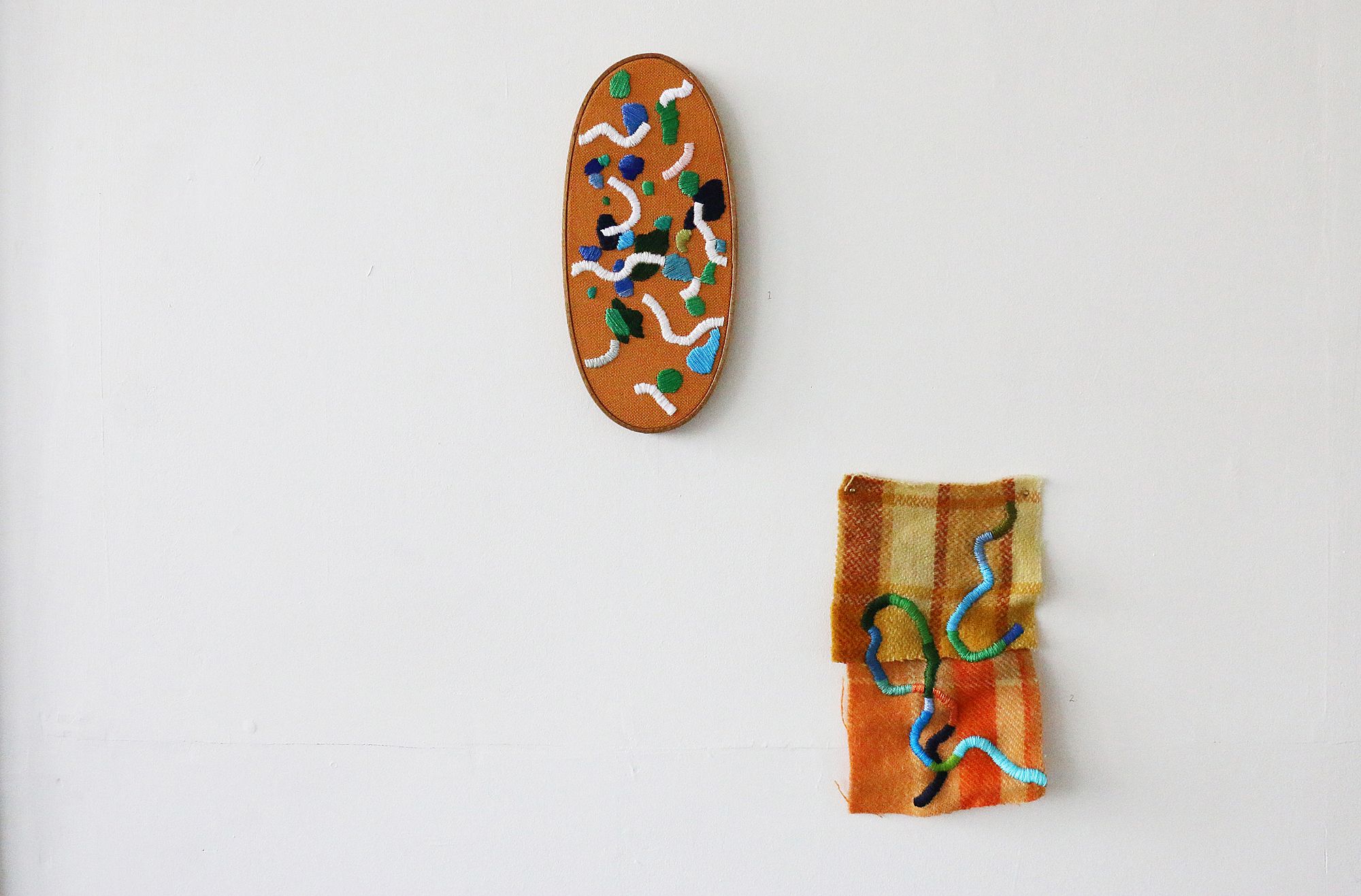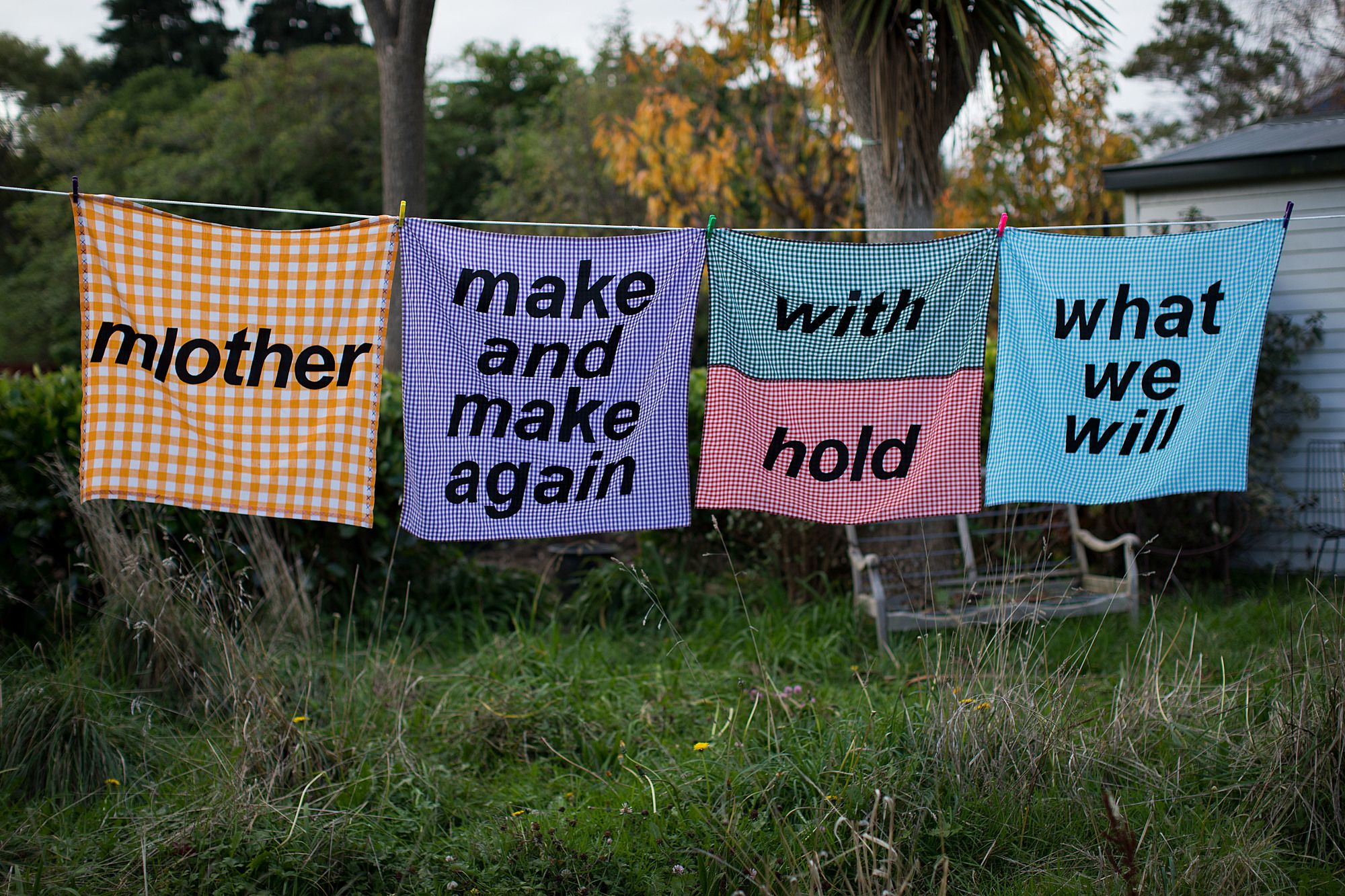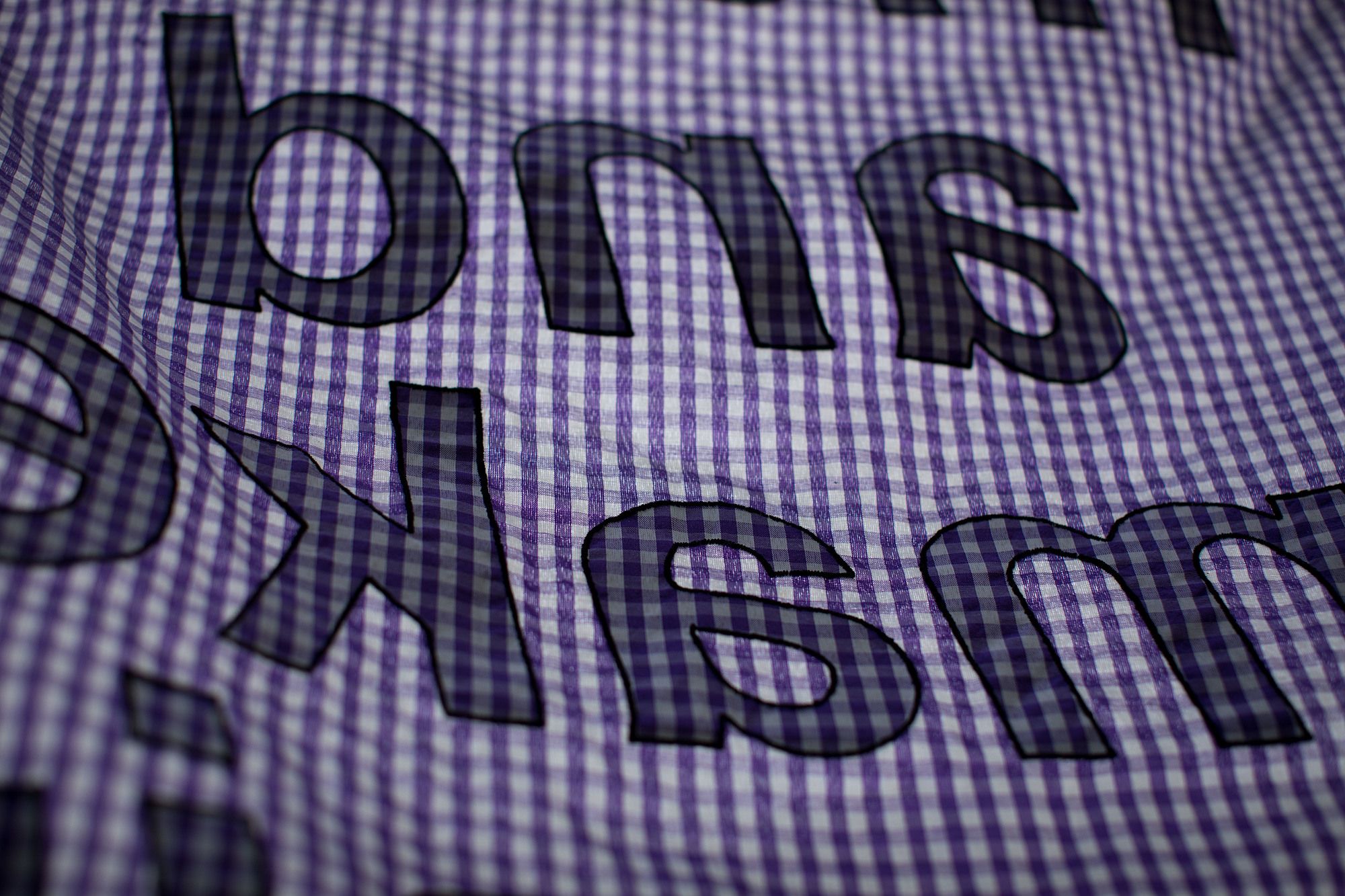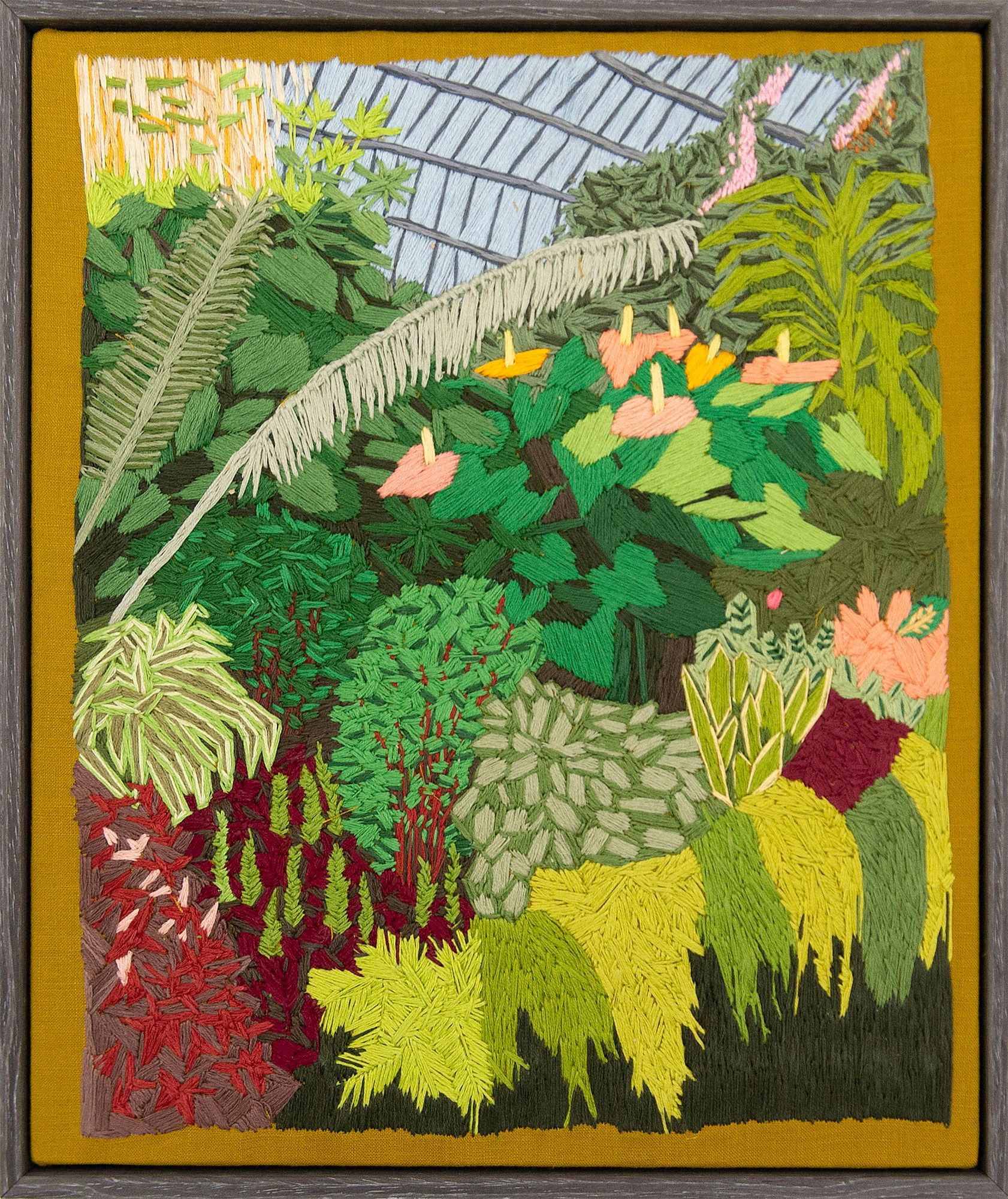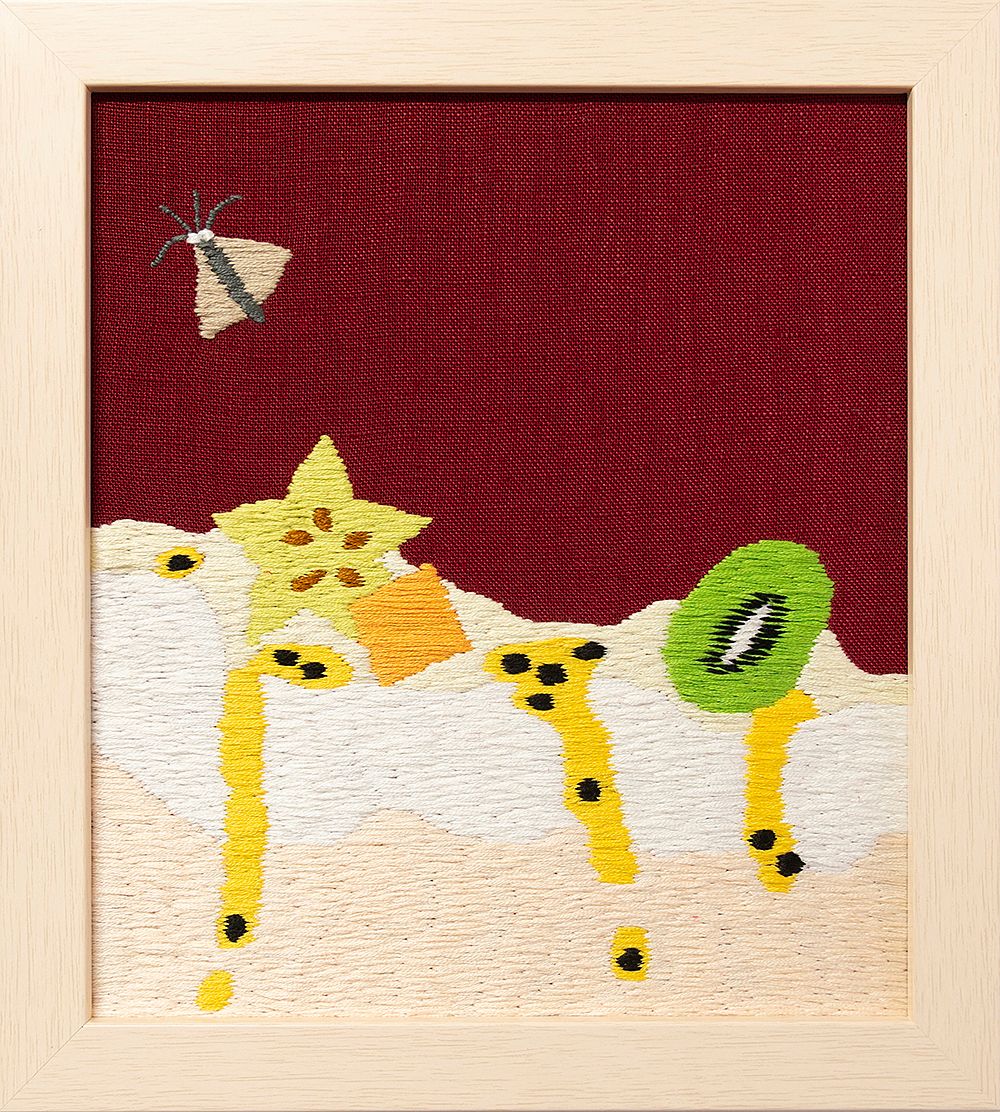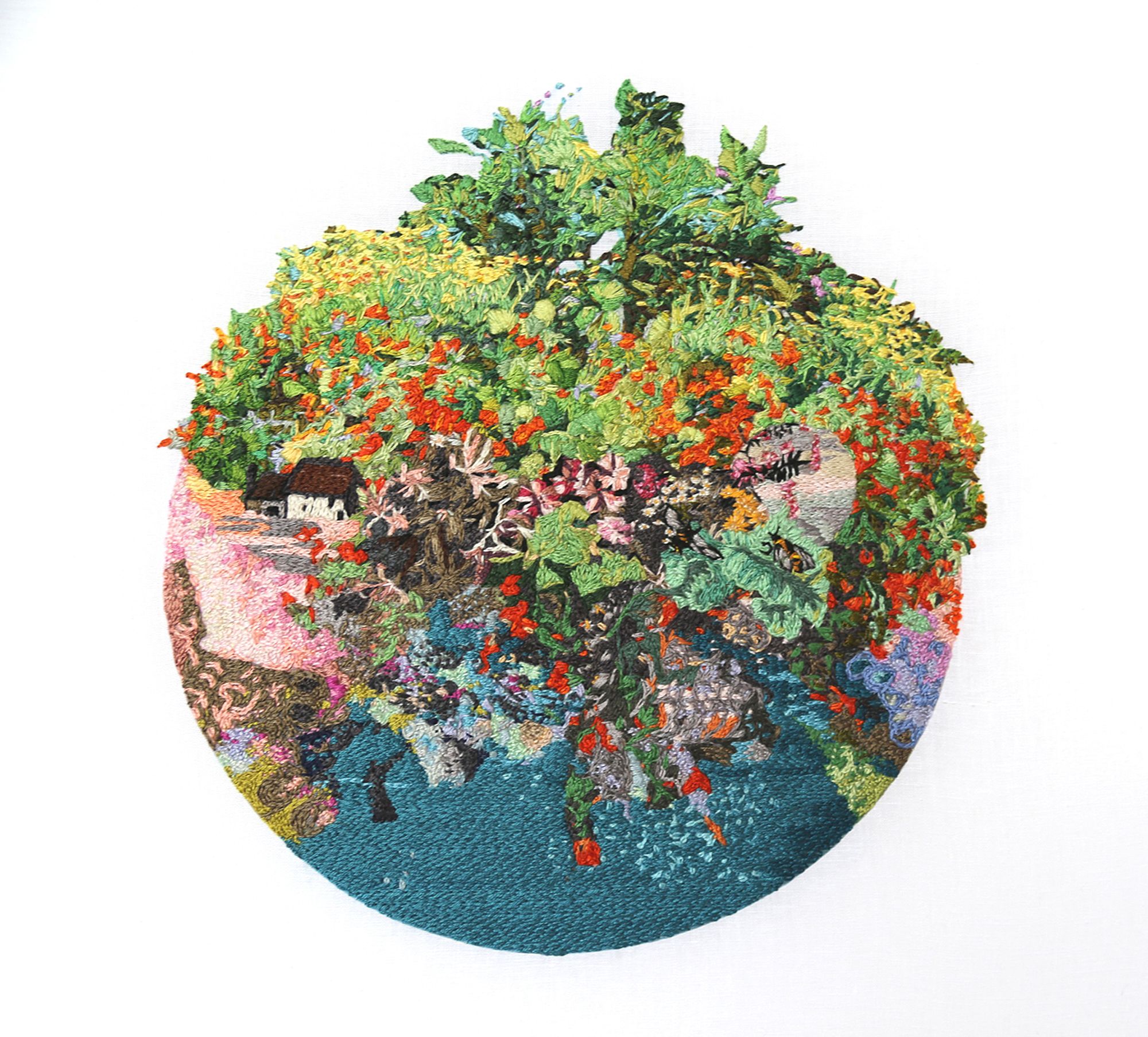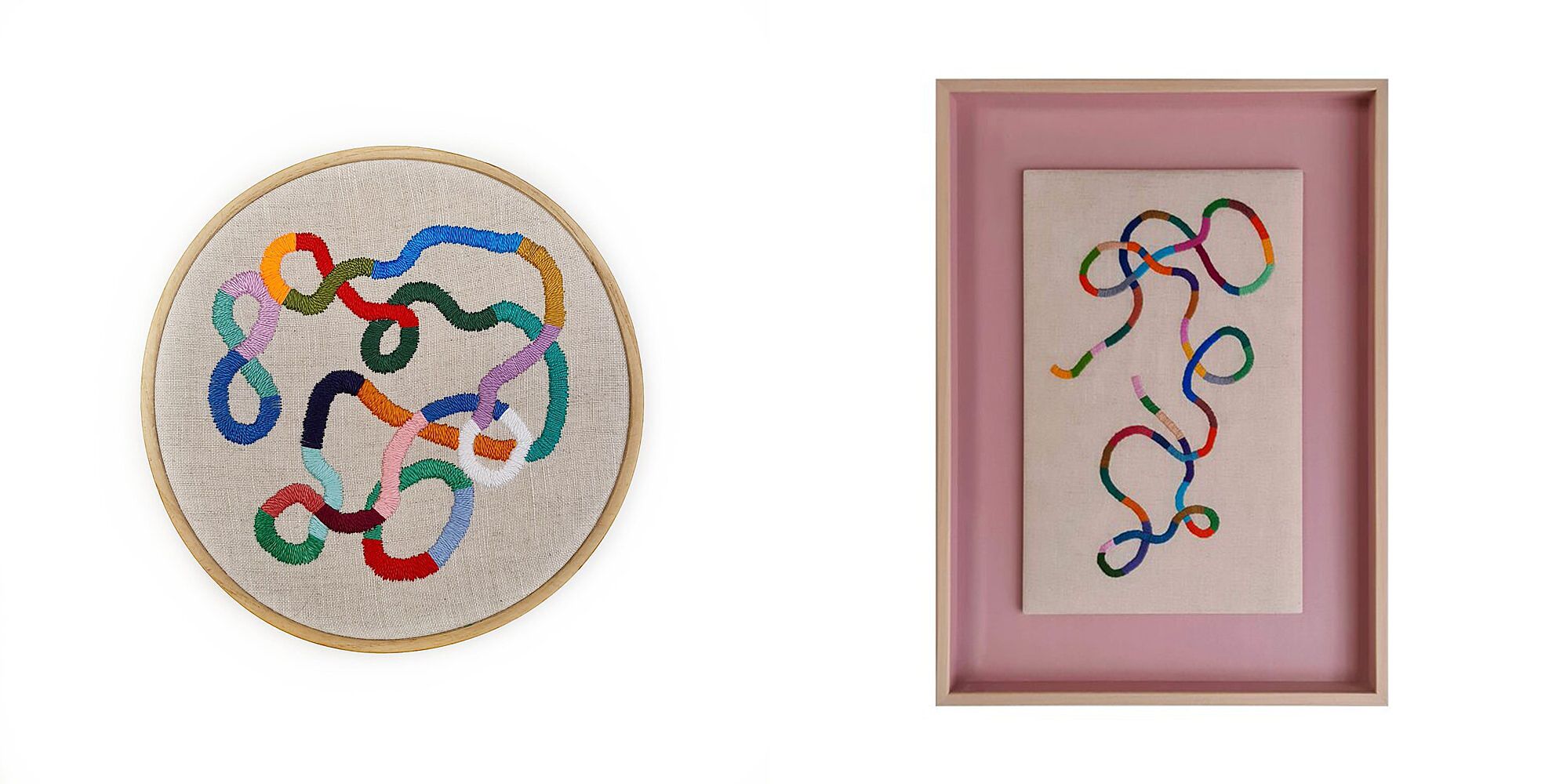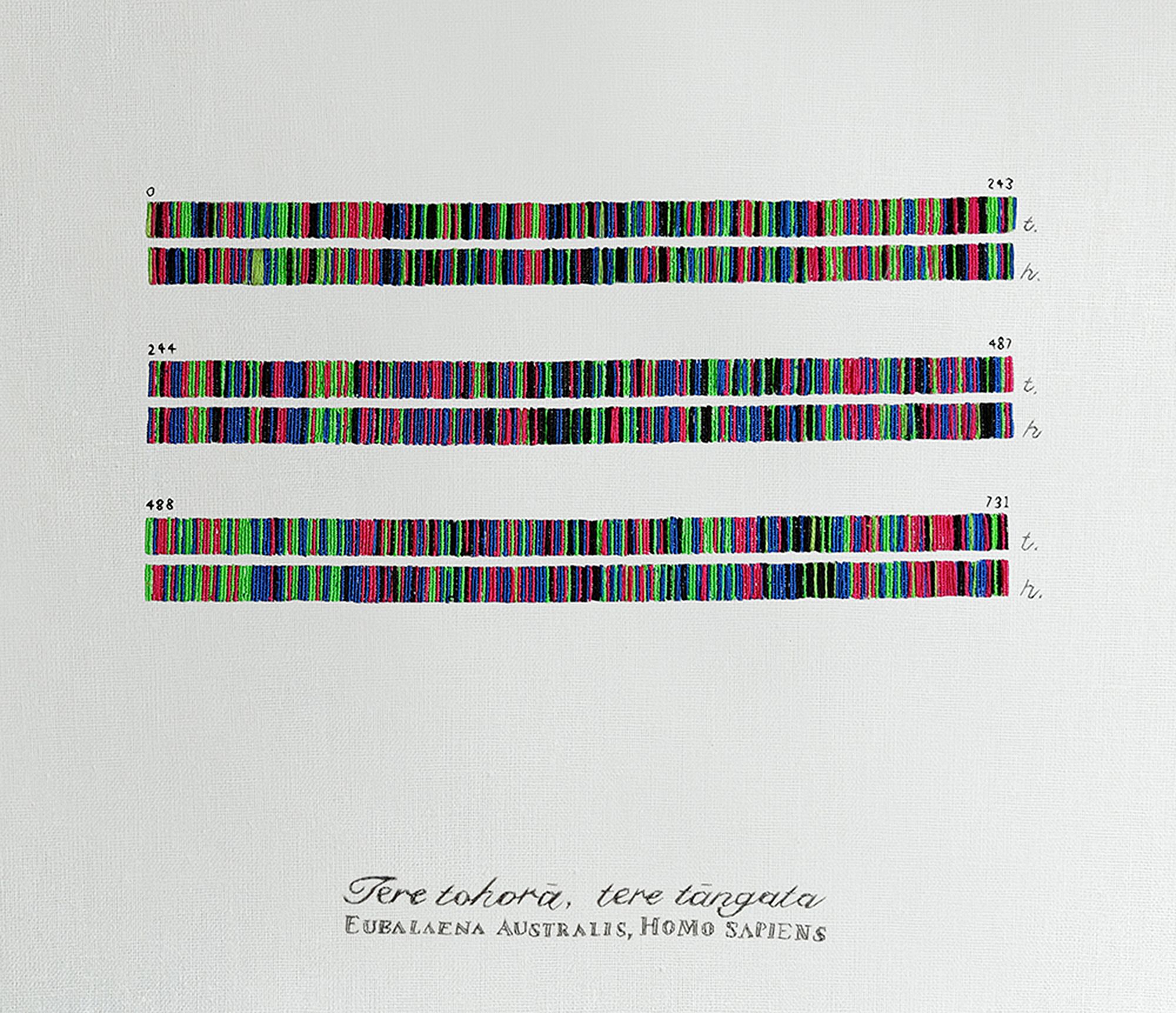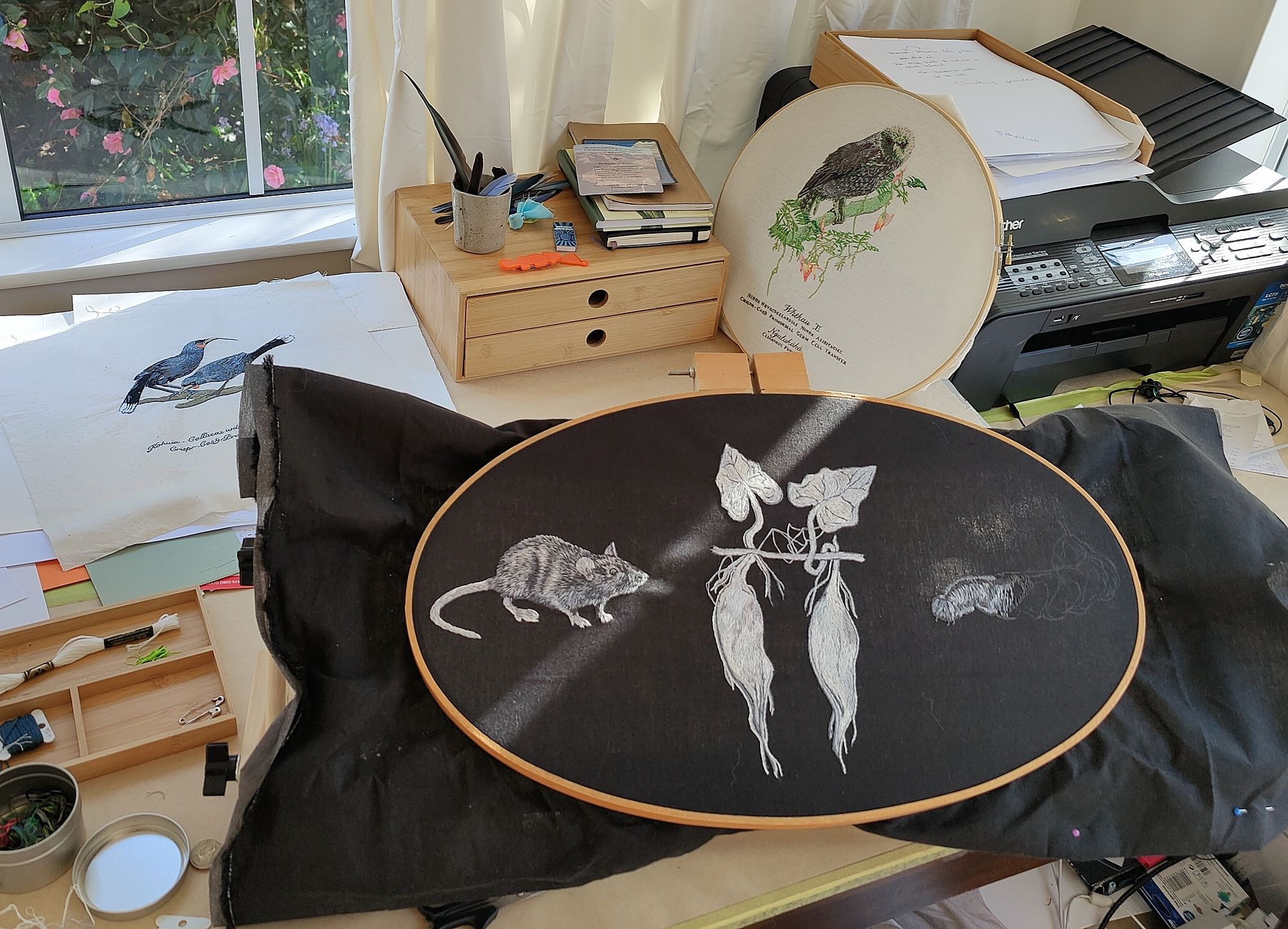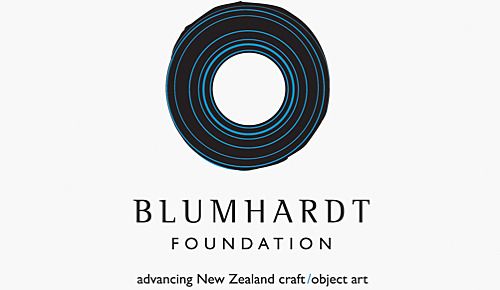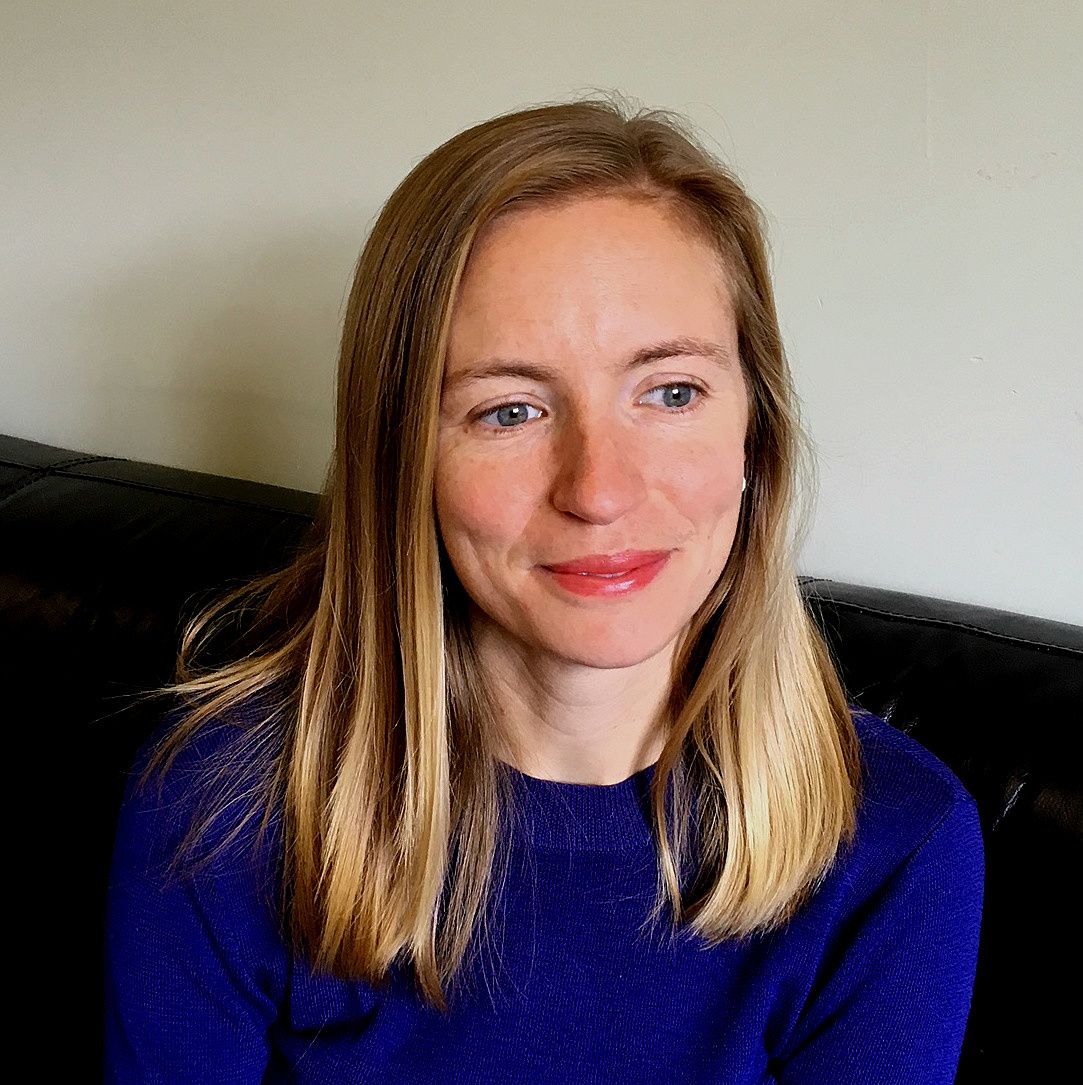Speculative Stitching: Aotearoa Artists and Embroidery
Thomasin Sleigh surveys contemporary New Zealand artists pushing the boundaries of embroidery – a medium that traverses craft and contemporary art contexts.
“Was Sol LeWitt interested in embroidery?” Zoe Thompson-Moore and I wonder. As far as we know, there’s no evidence of this in the American artist’s work but, we agree, the repetitive action of embroidery and its pre-established patterns might have been interesting to him. “When I was at art school,” Thompson-Moore says, “I was interested in two things: feminist art and performance art. I love anything durational, and I think needlework is a lot like the work those conceptual artists were making. It’s often painful and physically demanding.”
Conceptual and performance artists, from the 1960s onwards, often recorded the passing of time in their work and explored the metaphysical and nihilistic potential of repetition; works like Billy Apple’s sweeping, window cleaning and vacuuming works of the late 1960s and early 70s, or On Kawara’s assiduously hand-painted ‘date paintings’, which solely depict the date on which they were made. Embroidery, Thompson-Moore says, in its detailed, patterned repetition, and the practice of recording dates, names and places on samplers, has a similar way of enacting time. Perhaps there are untraced connections between these two modes of making art, one of which is increasingly valorised by the art world and market, and the other of which remains underrepresented?
Thompson-Moore is one of many artists in Aotearoa who embroider. The work and interests of these artists are disparate and resist the neat metaphor of a connective ‘thread’. A few arcs can be suggested, however, across the medium’s feminine, underwritten histories; its transmission through family and whānau; and its inherently repetitive physical process, forming a unique relationship with the hand and the mind.
Repetitive, detailed labour is integral to the work; enacting the acres of time women have spent throughout history
In 2019, Moore exhibited a series of appliqued banners in the exhibition M/other at the Whakatāne Museum. The words Thompson-Moore stitched made me think of the conceptualists of the 1970s and 80s, the kind of post-structural theory – the text made material and all that – that I was really into as a postgrad art history student. Thompson-Moore’s take on the legacies of conceptualism is much more nuanced than this, however. Her banners invoke repetition in both their language and construction; the statement ‘make and make again’, and the bold black text of all the banners, is meticulously hand stitched onto the bright gingham fabric, the borders neat and regular. Thompson-Moore was working right up to deadline to finish these works, completing a task that could have been easily done by a sewing machine. This repetitive, detailed labour is integral to the work; enacting the acres of time women have spent throughout history, stitching, mending and creating.
Zoe Thompson-Moore, M/other, Make and make again, With Hold, What we will, 2018–2019.
Zoe Thompson-Moore, Make and make again (detail), 2018–2019. Photos courtesy of the artist.
Another work by Thompson-Moore, motherload-motherlode (2019), further conflates the tactics of post-object art and textiles. In this work, Thompson-Moore and a group of friends (including me) gathered to build a massive pile of compost from seaweed, food scraps, and other materials gathered by Thompson-Moore from her home and nearby beaches. When the heap was finished, Thompson-Moore covered it with a square of found hessian that she had cross-stitched with the words ‘motherload’ and ‘motherlode’, using thread salvaged from old potato sacks. This cover was left to disintegrate into the compost as it decomposed, after which both were distributed to people at an open studio the artist held to mark the end of her Artist Residency in Motherhood.
Ephemerality, disintegration, collaborative action and performance – these are all hallmarks of conceptualism, but again Thompson-Moore complicates this reading by using cross-stitch and referencing motherhood, a medium and a subject position that are seldom found in the male-dominated history of post-object art, in Aotearoa or overseas. The word play of motherload-motherlode points to the contradictory nature of motherhood: as both creatively fruitful and burdensome; the definition of ‘lode’ being an ‘ore deposit’ or ‘abundant store’. And again, the use of cross-stitch points to the histories of feminine materials and those textile practices that have, until very recently, been underrepresented in art history and galleries.
Thompson-Moore studied at Ilam in the early 2000s and I ask her what the attitude was towards textiles and sewing in the art school at that time. Was she taught how to embroider? “The skills that we were offered in the sculpture department were casting techniques,” she replies. “And then there was the workshop, which was all wood and metal, and learning how to use the machinery. There was never the opportunity to learn needlework.”
Art schools don’t teach artists to embroider, but mums and nans do.
Erica van Zon, an artist well known for her colourful and clever embroidery, studied for her undergraduate degree at AUT at a similar time, where sewing techniques were not taught either. “If people were embroidering at art school, it would only have been a little bit of what they were doing,” van Zon says. “Or they would have done it for the drawing paper that we had to do... I can’t remember anyone going into embroidery in depth because those were the days of free abandoned sculpture. You’d just make heaps of stuff. You would just be casting aluminium just to see what would happen.” A hierarchy of artistic techniques persists, then. And in the dealer gallery world, as van Zon says, “Painting is still king.”
Van Zon’s embroideries are painting-like, in that she doesn’t follow a pattern or use a lot of different embroidery stitches (which are many and complex: satin stitch, hem stitch, ladder stitch, etc). “I don’t like to follow rules,” says van Zon, “I make up my own ways of working and end up stitching and filling in space like I’d use paint.” This is a modest way of describing van Zon’s vibrant embroideries – works like Cuningham House (2018), which shows the verdant foliage inside a glasshouse, all the plants and flowers competing for space inside the bustling frame of the image. It seems harder, with embroidery, to create the illusion of foreground and background, and van Zon plays up this inherent tension, crowding her works and forcing a kind of abstraction with the blunt, unmodulated blocks of thread.
Erica van Zon, Cuningham House, 2018, embroidery cotton on linen, from Peppermint Twist, Millers O'Brien. Courtesy of the artist.
Erica van Zon, The Pavlova is Melting on the Buffet, 2019, embroidery cotton on linen, from Six Days in Samoa, Auckland Art Fair. Courtesy of the artist.
Van Zon’s embroideries are also funny, and contradict the medium’s useful and pragmatic associations. In 2019, van Zon travelled to Sāmoa on holiday and made a series of works about this trip. She was wary of repeating the well-worn trope of an ‘island paradise’ and also of taking images from a culture about which she knew little. As a result, many of the works in this series, which was exhibited at the Auckland Art Fair in 2019, are tightly framed or zoomed in close, suggesting an outsider looking in, or a strictly limited view of events. I love The Pavlova is Melting on the Buffet (2019) from this series, linen embroidered with cotton, that for me evokes the sometimes dispiriting nature of travel: you get lost, you get hot, you don’t know the language, you order the pavlova, but it just melts. There’s also something very funny about Ch’i (2018), van Zon’s embroidered bottle of soft drink. Why is it funny? I’m not sure. Perhaps because Ch’i has always had a slightly outsider status in the pantheon of soft drinks – part sickly sweet, part refreshing. And here it is, mock heroic and singular in this stitched likeness.
Art schools don’t teach artists to embroider, but mums and nans do. Several of the artists that I spoke to for this article describe this knowledge being handed down by older relatives, whether through gentle osmosis or dedicated instruction, and how, even in the age of YouTube, it is important to them to have received these skills from their families. There is a significant generational shift to be highlighted here: in Aotearoa, baby boomers may have learnt embroidery formally at school, where it was an optional subject in the School Certificate curriculum from 1945 to 1970.1 However, even though embroidery was placed alongside Drawing and Design and Music in what was then the Fine Art curriculum, the medium was not able to shake off its domestic associations. As a chief examiner noted in 1948, “In too many schools embroidery has been regarded as a subject for the home course only and has failed so far to gain recognition rather as one of the fine arts.”2
At the time, embroidery was deeply enmeshed in the ideological view of women as passive and domestic. Rozsika Parker’s pioneering book The Subversive Stitch: Embroidery and the Making of the Feminine (1984)uncovers the way embroidery became a specifically feminine craft, in a European context, by tracking it from a practice undertaken by both men and women in medieval guilds, through to the 17th century when its status as an art form declined due to its association with industrious but subdued femininity. Does the thread tying embroidery to femininity persist in 2020? Yes. But contemporary artists highlight their homes and families as positive and generative, rather than downplaying these as distractions from real art making.
Materials with former lives prompt new ideas or new colour palettes.
Georgina May Young’s (Te Ūpokorehe, Pākehā) Instagram shows her home and creative life: tamariki, embroidery, weaving, gardening and exploring – interconnected sources of inspiration and creation. She writes, “There’s a deep ancestral connection and preciousness to landscape that I feel when rediscovering my whakapapa and being a mother – collecting imagery on walks in the bush, and swimming at any possible chance with my whānau.” Young’s nan was a tailor and she describes marvelling at her “intricate needlework, crochet lace, and wild colourful rug creations while munching on black doris plums and golden queen peaches.”
Young’s extraordinary embroidery is similar to this memory; it has a richly sensorial appeal. She stitches scenes of plants, birds, icebergs and mountains; dense worlds of stitch, thickly layered and intersecting. The mass and dexterity of her stitches rewards attentive viewing and when looking at her work the feeling accumulates that there is something hidden. In Untitled (2016) there is the suggestion of a cabin, a lake, tiny flowers, a cliff and the sense that you are simultaneously looking down on the details of a tiny rock pool and an expansive landscape from a vantage point high above.
Georgina May Young, Untitled, 2016. Courtesy of the artist.
Young places importance on both the foreground and background of her work and weaves the linen canvases that she embroiders onto. Like Thompson-Moore, Young is interested in embroidery’s supporting structures and aspects of the medium that are normally overlooked. She also uses found and second-hand material in her work, reusing linen and picking up interesting cotton while op shopping. Materials with former lives prompt new ideas or new colour palettes.
Alice Alva is similarly interested in the possibilities of old materials and the histories of embroidery. Some of Alva’s works are exhibited in vintage embroidery frames – they stay connected with their functional supports – and she embroiders onto old hospital blankets, doilies and linen dresses that she finds at op shops and picks apart.
Alva’s embroideries are filled with inversions and repetitions, as well as references to time passing
Alva has been busy recently, with two exhibitions just opened in Hamilton, one at the Framing House, and the other, in the centre of love with you, with fellow embroidery artist Wesley John Fourie at Never Project Space. Many of Alva’s recent embroideries are bright and colourful; blocks of stitched colour interlock with each other in densely patterned compositions. Her patterns and colours bring to mind the modernist women artists of the early 20th century who used textiles in their art and have only recently begun receiving the critical recognition that they are due. Sonia Delaunay, for example, whose work was surveyed in a big show at the Tate Modern, and Louise Henderson, who was integral to the teaching of embroidery here in Aotearoa and who was recently the subject of a retrospective,Louise Henderson: From Life,at Auckland Art Gallery. Significantly, this show didn’t include Henderson’s embroidery, but her work in textiles was examined in an essay by Linda Tyler in the accompanying catalogue.
Alva’s recent works use thread to depict thread in a kind of feedback loop. Threadbare (2018) is stitched on an oversized linen dress that Alva found while op shopping. The colourful embroidered thread wriggles snake-like around the linen but only links up in another related work – Enclosed/closing-en (2020), also stitched on the same repurposed linen – where the thread finds its end point and creates a full circle. Alva’s embroideries are filled with inversions and repetitions, as well as references to time passing and the repetitive action of stitching. Threads Loose (2020) was exhibited as part of in the centre of love with youand can be read as another work in this small series, except here the threads have escaped their cyclical loop and are loose and linear, squirming on two bits of found hospital blanket.
(left) Alice Alva,Threadbare, 2018. Courtesy of the Framing House. (right) Alice Alva, Enclosed/Closing-en, 2020. Courtesy of the Framing House.
There are many other contemporary artists in Aotearoa who embroider in fascinating ways: Jay Hutchinson, Ruby Joy Eade, Vita Cochran, Sarah Munro, Quishile Charan, Wesley John Fourie (mentioned earlier) and Areez Katki (whose work has been featured on the Pantograph Punch), to name a few. The work of these artists intersects with both the art and craft worlds and often reveals these distinctions to be redundant, or, at least, open to critical examination. Embroidery is alive in Aotearoa and in this unique pandemic year when most people have spent lots of time occupying themselves alone in their homes, creating with materials literally close to hand, the transportability and the meditative repetition of embroidery perhaps give the medium a further renewed relevance in 2020.
But it’s an upcoming exhibition, Whakatau Miromiro, at Aratoi: Wairarapa Museum of Art and History by Terri Te Tau (Rangitāne, Ngāti Kahungunu) that I want to finish on – an exhibition that draws on, and messes with, embroidery’s association with the handmade.
Te Tau (who is also a member of the Mata Aho Collective) describes her medium as ‘speculative embroidery’ and Whakatau Miromiro looks at the connections between the indigenous fauna and flora of Aotearoa and the different ways that these connections can be visualised and understood. Māori scientists working in genomics use whakataukī to guide their research and articulate the close relationships between species; in the exhibition, Te Tau will layer these whakataukī with machine-embroidered visualisations of the DNA of different indigenous animals and plants. The machine embroidery allows for the intricate detail required to depict DNA, and the works, such as Tere tohorā, tere tāngata; DNA sequence data (2020), have a spare, chromatic beauty, reminiscent of a Ralph Hotere painting. Also in the exhibition will be exquisite hand-embroidered images of both existing and imagined birds and other taonga species, such as kiore and kūmara.
Terri Te Tau, Tere tohorā, tere tāngata; DNA sequence data, 2020. Courtesy of the artist.
Terri Te Tau, works in progress for Whakatau Miromiro, Aratoi: Wairarapa Museum of Art and History, 2020
As a medium that she learnt from her nan, and one that is based on webs, connections and continuity, embroidery makes complete conceptual sense for Te Tau’s art. She writes that an ‘aho’ in te reo Māori is both a thread and a line of descent. “This analogy appears a lot in the context of customary whatu and weaving.” Using embroidery to align mātauranga Māori and genomics, Te Tau’s ‘speculative embroidery’ in Whakatau Miromiro is just that; the flexibility of the medium allows her to reveal connections and visualise knowledge in a way that is part sci-fi, part minimalist painting and part botanical illustration. Te Tau – by hand, and with her machines – has stitched something wholly new.
[1] Vivien Caughley, New Zealand’s Historic Samplers: Our Stitched Stories (Auckland: David Bateman, 2014), 143.
[2] Appendix to the Journal of the House of Representatives, E-2, 1948, Primary and Post Primary Education, 15.
Blumhardt Foundation logo
This piece is presented as part of a partnership with Blumhardt Foundation. They cover the costs of paying our writers while we retain all editorial control.
Feature image: Alice Alva, Wildling, 2020 and Thread Loose, 2020. Courtesy of Never Project Space.
